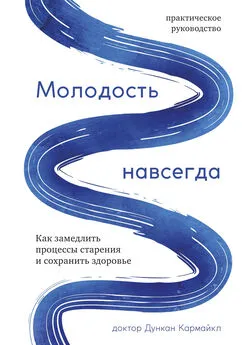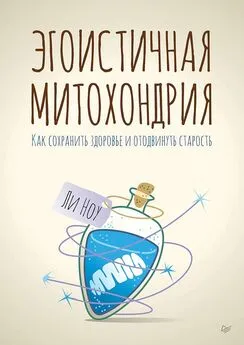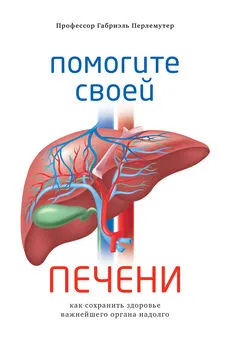Дункан Кармайкл - Молодость навсегда. Как замедлить процессы старения и сохранить здоровье
- Название:Молодость навсегда. Как замедлить процессы старения и сохранить здоровье
- Автор:
- Жанр:
- Издательство:неизвестно
- Год:2018
- ISBN:978-5-389-18963-8
- Рейтинг:
- Избранное:Добавить в избранное
-
Отзывы:
-
Ваша оценка:
Дункан Кармайкл - Молодость навсегда. Как замедлить процессы старения и сохранить здоровье краткое содержание
«Современный мир дает возможность как поддерживать здоровье в пре-красном состоянии, так и еще в молодом возрасте „заработать“ тяжелые хронические заболевания. Очевидно, что в большинстве случаев наше здоровье в наших руках. Вопрос в том, как определить, что помогает, а что вредит? Все так быстро меняется во всех областях медицины, что вчерашнее лекарство завтра может быть признано вредным (и это не учитывая аферистов в белых халатах, пытающихся впарить шарлатанские средства от всех болезней). Поиск надежной информации в эпоху интернета становится нелегкой задачей. Моя цель – составить для вас полезную дорожную карту». (Дункан Кармайкл)
В формате PDF A4 сохранён издательский дизайн.
Молодость навсегда. Как замедлить процессы старения и сохранить здоровье - читать онлайн бесплатно ознакомительный отрывок
Интервал:
Закладка:
340
Berk, M. et al. ‘N-acetylcysteine for Depressive Symptoms in Bipolar Disorder. A Randomised Placebo-controlled Trial.’ Biol Psychiatry (2008): 64, 6: 468–475.
341
Cerami, A. et al. ‘Glucose and Aging.’ Sci Am (1987): 256: 90–96.
342
Smith, M. A. et al. ‘Advanced Maillard Reaction End Products are Associated with Peroxisome Proliferations.’ Chem Biol Interact (1999): 1–3: 205–218.
343
Bierhaus, A. et al. ‘Advanced Glycation End Product-Induced activation of NF Kappa B is Suppressed by Alpha-lipoic Acid in Cultured Endothelial Cells.’ Diabetes (1997): 47: 1481–1490.
344
Asgary, S. et al. ‘Antioxidant Effects of Flavonoids on Haemoglobin Glycosylation.’ Pharm Acta Helv (1999): 73: 223–226.
345
Song, D. et al. ‘Chronic N-acetylcysteine Prevents Fructose-induced Insulin Resistance and Hypertension in Rats.’ Eur J Pharmacol (2005): 508: 205–210.
346
Masha, A. et al. ‘Prolonged Treatment with N-acetylcysteine and L-arginine Restores Gonadal Function in Patients with PCO Syndrome.’ J Endocrinol Invest (2009). Nakagawa, T. et al. ‘Protective Activity of Green Tea Against Free Radical and Glucose Mediated Protein Damage.’ J Agric Food Chem (2002): 50: 2418–2422.
347
Koschinsky, T. et al. ‘Orally-absorbed Reactive Glycation Products (Glycotoxins): An Environmental Risk Factor in Diabetic Nephropathy.’ Proc Natl Acad Sci USA (1997): 94: 6474–6479.
348
Halvorsen, B. L. et al. ‘Determination of Lipid Oxidation Products in Vegetable Oils and Marine Omega-3 Supplements.’ Food Nutr Res (2011): 55.
349
Boor, P. et al. ‘Regular Moderate Exercise Reduces Advanced Glycation and Ameliorates Early Diabetic Nephropathy in Obese Zucker Rats.’ Metabolism (2009): 58: 1669–1677.
350
Flatley, J. ‘The nature of violent crime in England and Wales: year ending March 2017.’ The Oice of National Statistics.
351
Salleh, R. M. ‘Life event, stress and illness.’ Malays J Med Sci (2008): 15: 9–18.
352
Sapolsky, R. M. Why Zebras Don’t Get Ulcers: An Updated Guide to Stress, Stress-Related Diseases and Coping. W. H. Freeman (1994).
353
Lowe, S. et al. ‘Control of Apoptosis by p53.’ Oncogene (2003): 22: 9030–9040.
354
Makoto, R. et al. ‘A Stress Response Pathway Regulates DNA Damage Through B 2-adrenoreceptors and B-arrestin.’ Nature (online): 21 August 2011.
355
Misra, M. et al. ‘Higher Cortisol Associated with Greater Visceral Adiposity.’ Am J Physiol Endocrinol Metab (2008): 295 (2).
356
Straub, R. et al. ‘Inadequately Low Serum Levels of Steroid Hormones in Relation to IL6 and Tumour Necrosis Factor in Untreated Patients with Early Rheumatoid Arthritis.’ Arthritis Rheum (2002): 654–662.
357
Khani, S. et al. ‘Cortisol Increases Glucose-Genesis in Humans: Its Role in the Metabolic Syndrome.’ Clinical Sciences (2001): 101: 739–747.
358
Dhabhar, F. S. et al. ‘Acute Stress Enhances While Chronic Stress Suppresses Cell-Mediated Immunity In Vivo: A Potential Role for Leukocyte Traicking.’ Brain Behav Immun (1997): 11 (4): 286–306.
359
Reiche, E. M. V. et al. ‘Stress, Depression, the Immune System and Cancer.’ Lancet Oncol (2004): 5: 617–625.
360
Jeferies, W. M. Safe Uses of Cortisol. Charles C. Thomas Pub Ltd, 3rd Ed (2004), pp. 3–9.
361
Hench, P. S. et al. ‘The Effect of a Hormone of the Adrenal Cortex on Rheumatoid Arthritis.’ Preliminary Report. Proc Staf Meet, Mayo Clinic (1949): 24: 181–197.
362
Jeferies, W. M. Safe Uses of Cortisol. Charles C. Thomas Pub Ltd, 3rd Ed (2004), pp. 3–9.
363
Jeferies, W. M. ‘Low-Dosage Glucocorticoid Therapy.’ Arch Intern Med (1967): 119: 265–278.
364
Steptoe, A, et al. ‘Depression and Elevated Cortisol.’ Am J Epidemiol (2008): 167 (1): 96–102.
365
Lupien, S. et al. ‘The Douglas Hospital Longitudinal Study of Normal and Pathological Ageing.’ J Psych of Neuroscience (2005): 30: 328–334.
366
Swaab, D. F. et al. ‘Elevated Cortisol in Rats Induces Neuronal Damage.’ Ageing Res Rev (2005): 4 (2): 141–194.
367
Stenius, F. et al. ‘Salivary Cortisol Levels and Allergy in Children: the ALADDIN Birth Cohort.’ J Clin Immune (2011).
368
Hedman, M. et al. ‘Low Blood and Synovial Fluid Levels of Conjugated Steroids in Rheumatoid Arthritis.’ Clin Exp Rheumatol (1992) 10: 25–30.
369
Strickland, P. et al. ‘A Comparison of Salivary Cortisol in Chronic Fatigue Syndrome, Community Depression and Healthy Controls.’ Journal of Af ective Disorders (1998): 47: 191–194.
370
Dunkelmann, S. S. et al. ‘Cortisol Metabolism in Obesity.’ J Clin Endocrinol Metab (1964): 24: 832–841.
371
Szafarczyk, A. et al. ‘Further Evidence for a Central Stimulatory Action of Catecholamines on Adrenocorticotropin Release in the Rat.’ Endocrinology (1987): 121 (3): 121.
372
Figueiro, M. and Rea, M. S. ‘The Effects of Red and Blue Light on Circadian Variations in Cortisol, Alpha Amylase, and Melatonin.’ International Journal of Endocrinology (2010): ID 829351.
373
Jung, H. J. et al. ‘Effect of Testosterone Replacement Therapy on Cognitive Performance and Depression in Men with Testosterone Deficiency Syndrome.’ World J Men’s Health (2016): 34: 194–199.
374
Arlt, W. et al. ‘DHEA replacement in women with adrenal insui ciency – pharmacokinetics, bioconversion and clinical effects on well-being, sexuality and cognition.’ Endocrine Research (2000): 26: 505–511. URL: http://www.tandfonline.com/doi/abs/10.3109/07435800009048561.
375
Sarrel, P. M. et al. ‘The mortality toll of oestrogen avoidance: an analysis of excessive deaths among hysterectomized women aged 50 to 59 years.’ Am J Public Health (2013): 103: 1583–1588.
376
Basaria, S. et al. ‘Adverse events associated with testosterone administration.’ N Engl J Med (2010): 363 (2): 109–122.
377
Levine, H. et al. ‘Temporal Trends in Sperm Count: A Systematic Review and Meta-Regression Analysis.’ Hum Reprod Update (2017): 1–14.
378
‘Ageing and health.’ World Health Organization. http://www.who.int/mediacentre/factsheets/fs404/en/.
379
Vermeulen, A. et al. ‘The apparent free testosterone concentration: An index of androgenicity.’ J Clin Endocrinol Metab (1971): 33: 759–767.
380
Kaufman, J. M. et al. ‘Androgens in male senescence.’ In Nieschlag, E., Behre, H. M. eds. Testosterone action, deficiency, substitution. Berlin, Springer-verlag (1998): 437–471. Liefke, E. et al. ‘Age-related changes of serum sex hormones, insulin-like growth factor-1 and SHBG levels in men: cross-sectional data from a healthy male cohort.’ Clin Endocrinol (Oxford) (2000): 53: 689–695.
381
Stellato, R. K. et al. ‘Testosterone, SHBG and the development of type-2 diabetes in middle-aged men: prospective results from the Massachusetts Male Ageing Study.’ Diabetes Care (2000): 23: 490–494.
382
Mof at, S. D. et al. ‘Longitudinal assessment of serum free testosterone concentration predicts memory performance and cognitive status in elderly men.’ J Clin Endocrinol Metab (2002): 87: 5001–5193.
383
Mof at, S. D. et al. ‘Free testosterone and risk for Alzheimer’s disease in older men.’ Neurology (2004): 62: 188–193. Braga-Basaria, M. et al. ‘Metabolic syndrome in med with prostate cancer undergoing long-term androgen deprivation therapy.’ J Clin Oncol (2006): 24: 3979–3983.
384
Selvin, E. et al. ‘Androgens and diabetes in men: results from the third National Health and Nutrition Examination Survey (NAHANES III).’ Diabetes Care (2007): 30: 234–238.
385
Rosano, G. M. et al. ‘Low testosterone levels are associated with coronary artery disease in male patients with angina.’ Int J Impot Res (2007): 19: 176–182.
386
Khaw, K. T. et al. ‘Endogenous testosterone and mortality due to all causes, cardiovascular disease and cancer in men. EPIC-Norfolk prospective population study.’ Circulation (2007): 116: 2694–2701.
387
Malkin, C. J. et al. ‘The effect of testosterone replacement on endogenous infl ammatory cytokines and lipid profiles in hypogonadal men.’ J Clin Endocrinol Metab (2004): 89: 3313–3318.
388
Oppenheim, D. S. et al. ‘Elevated serum lipids in hypogonadal men with and without hyperprolactinaemia.’ Ann Intern Med (1989): 111: 288–292.
389
Hanke, H. et al. ‘Effect of testosterone on plaque development and androgen receptor expression in the arterial vessel wall.’ Circulation (2001): 103: 1382–1385.
390
Malkin, C. J. et al. ‘The effect of testosterone replacement on endogenous infl ammatory cytokines and lipid profiles in hypogonadal men.’ J Clin Endocrinol Metab (2004): 89: 3313–3318.
391
Rubinow, K. B. et al. ‘Testosterone replacement in hypogonadal men alters the HDL proteome but not HDL cholesterol el ux capacity.’ J Lipid Res (2012): 53: 1376–1383. Nettleship, J. E. et al. ‘Physiological testosterone replacement therapy attenuates fatty streak formation and improves high density lipoprotein cholesterol in the Tfm mouse.’ Circulation (2007): 116: 2427–2434.
392
Hanke, H. et al. ‘Effect of testosterone on plaque development and androgen receptor expression in the arterial vessel wall.’ Circulation (2001): 103: 1382–1385.
393
Hackett, G. et al. ‘Testosterone replacement therapy improves metabolic parameters in hypogonadal men with type 2 diabetes but not in men with coexisting depression: the BLAST study.’ J Sex Med (2014): 11: 840–856.
394
Dhinsa, S. et al. ‘Insulin Resistance and Infl ammation in Hypogonadotropic Hypogonadism and Their Reduction After Testosterone Replacement in Men With Type 2 Diabetes.’ Diabetes Care (2016): 39: 82–91.
395
Cherrier, M. M. et al. ‘Testosterone improves spatial memory in men with Alzheimer’s disease and mild cognitive impairment.’ Neurology (2005): 64: http://n.neurology.org/content/64/12/2063.full.
396
Vigen, R. et al. ‘Association of testosterone therapy with mortality, myocardial infarction, and stroke in men with low testosterone levels.’ JAMA (2013): 310: 1829–1836.
Читать дальшеИнтервал:
Закладка:










